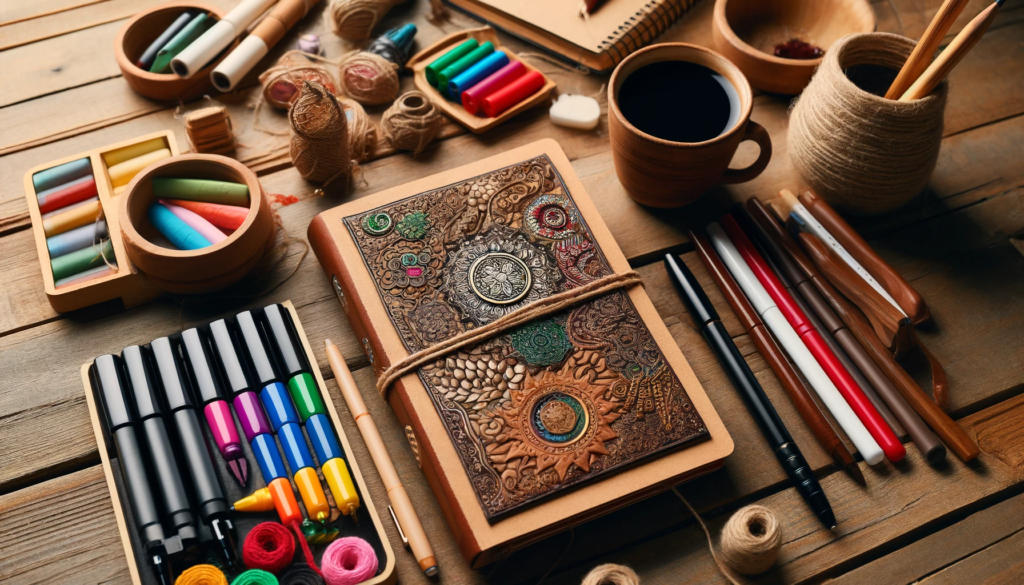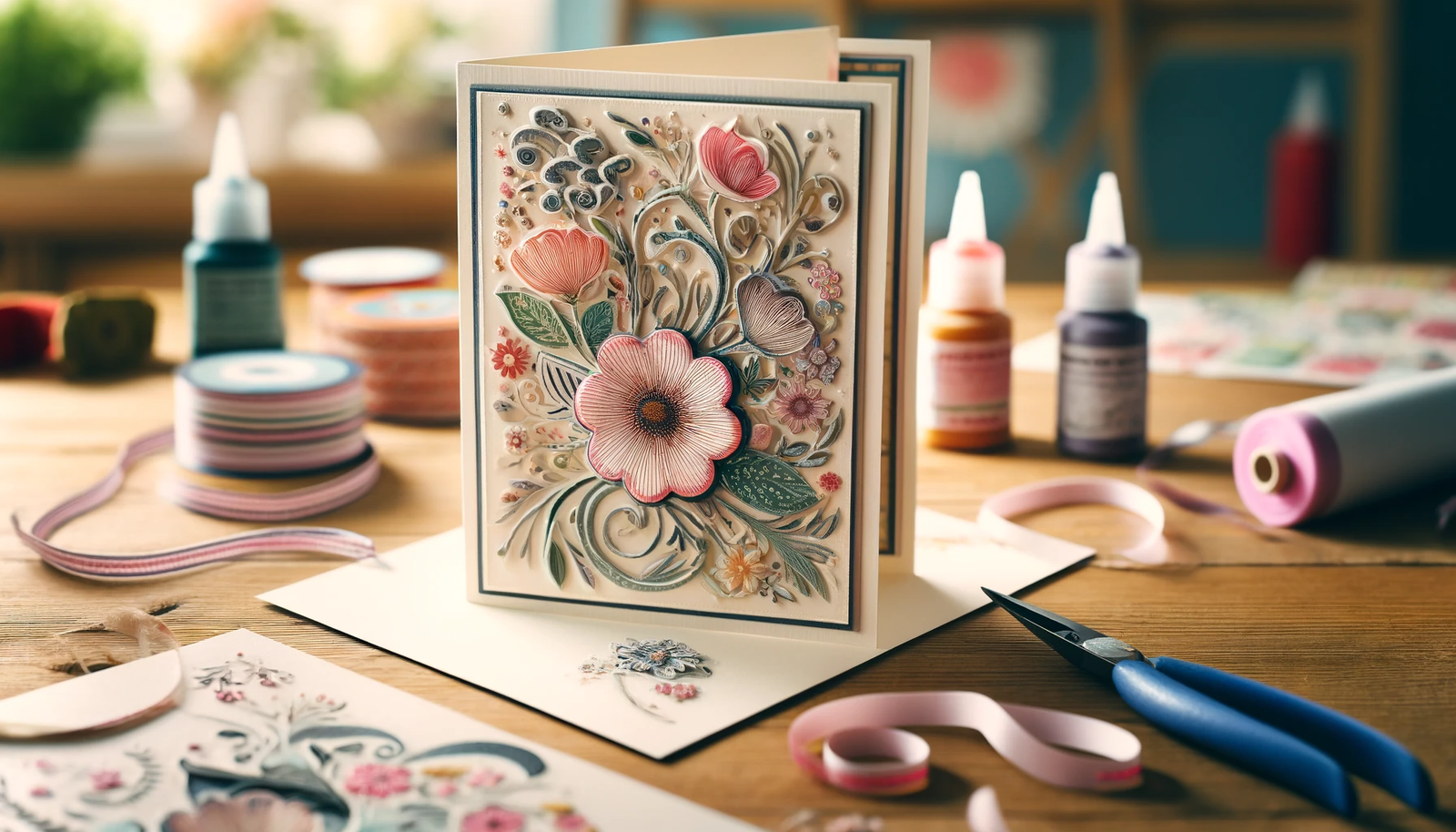Part 1
Have you ever considered creating your own personal journal but felt overwhelmed by where to start? Our DIY Bookbinding Guide is here to help! Bookbinding is not only a functional craft but also a rewarding form of creative expression. Whether you’re a seasoned crafter or a complete beginner, this comprehensive guide will walk you through the process step by step.
Why Choose DIY Bookbinding?
Creating your own journal allows you to personalize every aspect, from the type of paper to the design of the cover. This personal touch makes your journal unique and tailored to your needs. Moreover, the process of making a journal can be therapeutic and fulfilling. As you bind your pages together, you are crafting a space for your thoughts, dreams, and ideas.
Benefits of Bookbinding
- Personalization: Customize your journal to reflect your personality and preferences.
- Creative Expression: Engage in a craft that combines art and utility.
- Cost-Effective: Often cheaper than buying high-quality pre-made journals.
- Sustainable: Use recycled materials to create eco-friendly journals.
- Skill Development: Learn and hone a valuable crafting skill.
What You Will Learn
In this guide, you will learn about the different types of bookbinding techniques, the materials needed, and the step-by-step process for creating your own journals. We’ll cover basic techniques suitable for beginners and more advanced methods for those looking to take their skills to the next level. Additionally, we’ll provide tips on personalizing your journal and troubleshooting common issues.
By the end of this guide, you’ll be equipped with the knowledge and confidence to create beautiful, functional, and personalized journals.
Section 1: Understanding Bookbinding
What is Bookbinding?
Bookbinding is the process of assembling and securing written or printed pages within a cover. This craft dates back centuries and has evolved significantly, incorporating various techniques and materials. In essence, bookbinding transforms loose pages into a cohesive, durable, and often beautiful book.
A Brief History of Bookbinding
The art of bookbinding began in ancient times when early civilizations sought ways to compile and protect important documents. The Egyptians, Greeks, and Romans used simple methods to bind papyrus scrolls. The true evolution of bookbinding, however, began during the medieval period with the introduction of codices. Monks meticulously bound hand-copied manuscripts, using intricate stitching and lavish covers to create works of art.

In the 15th century, the invention of the printing press revolutionized book production. Techniques such as perfect binding, saddle stitching, and Coptic stitching emerged, each offering unique advantages. Today, bookbinding combines traditional methods with modern innovations, making it accessible to hobbyists and professionals alike.
Different Types of Bookbinding

Understanding the various bookbinding techniques is crucial for choosing the right method for your project. Here are some of the most common types:
1. Saddle Stitching
Saddle stitching is a simple and cost-effective binding method ideal for thin booklets and pamphlets. It involves folding sheets of paper in half and stapling them along the fold. This method is quick and requires minimal materials.
- Pros: Easy to do, inexpensive, and perfect for small projects.
- Cons: Limited to a small number of pages, not very durable.
2. Perfect Binding
Perfect binding, commonly used for paperback books, involves gluing the edges of the pages to a spine. This method creates a clean and professional look, making it popular for novels and magazines.
- Pros: Professional appearance, suitable for thicker books.
- Cons: Less durable than other methods, especially with frequent use.
3. Coptic Stitching
Coptic stitching is an ancient technique known for its flexibility and durability. This method involves sewing sections of pages together through their folds and attaching them to the cover using chain stitches. The result is a book that lies flat when open, making it ideal for journals and sketchbooks.
- Pros: Lies flat when open, durable, aesthetically pleasing.
- Cons: More time-consuming and requires more materials and skill.
4. Japanese Stab Binding
Japanese stab binding is a decorative and sturdy technique that involves stitching through the entire thickness of the book’s spine. This method is perfect for binding single sheets of paper and allows for creative patterns along the spine.
- Pros: Decorative, strong, and can bind single sheets.
- Cons: Does not open flat, more complex stitching patterns.
5. Case Binding
Case binding, also known as hardcover binding, involves sewing the pages together and attaching them to a hard cover. This is the most durable and protective binding method, commonly used for high-quality books and keepsakes.
- Pros: Extremely durable, offers the best protection, professional look.
- Cons: Requires more materials and time, more complex process.
Section 2: Materials Needed for Bookbinding

Essential Tools and Materials for DIY Bookbinding
To start your DIY bookbinding journey, gathering the right tools and materials is crucial. Having the correct supplies will not only make the process smoother but also ensure that your final product is sturdy and aesthetically pleasing. Here’s a comprehensive list of essential tools and materials you’ll need:
Paper Types for Journals
The type of paper you choose can significantly impact the functionality and appearance of your journal. Here are some options to consider:
- Text Weight Paper: Commonly used for the pages of a journal, this paper is smooth and comes in various weights. It’s ideal for writing and drawing.
- Watercolor Paper: Heavier and more textured, perfect for artists who want to use watercolors in their journals.
- Recycled Paper: An eco-friendly option that adds a unique texture and look to your journal.
- Lined or Dotted Paper: Pre-printed with lines or dots, these are perfect for those who prefer guided writing or drawing.
Binding Tools
A successful bookbinding project requires specific tools designed to handle various aspects of the process. Here are the essentials:
- Bone Folder: Used for creasing and folding paper smoothly.
- Awl: A sharp tool used to punch holes through paper and cover material.
- Needles: Large-eyed needles are ideal for threading binding thread.
- Binding Thread: Strong, waxed thread that holds the pages together securely.
- Ruler and Cutting Mat: For measuring and cutting paper accurately.
- Scissors and X-Acto Knife: Essential for cutting paper and cover materials to size.
Cover Materials for DIY Journals
The cover of your journal not only protects the pages but also provides an opportunity to express your creativity. Consider these materials:
- Cardstock: Sturdy and available in various colors and patterns, perfect for a simple cover.
- Leather: Durable and luxurious, ideal for a long-lasting journal.
- Fabric: Adds a soft and tactile element to your journal, available in countless designs.
- Chipboard: Provides a strong base, often used with decorative paper or fabric overlays.
Adhesives and Cutting Tools
Choosing the right adhesive and cutting tools ensures that your journal is both functional and durable. Here are some key items:
- PVA Glue: A strong adhesive that dries clear, commonly used in bookbinding.
- Glue Stick: Useful for light adhesive tasks and securing small items.
- Double-Sided Tape: Ideal for attaching covers and other decorative elements.
- Rotary Cutter: Provides clean, straight cuts through multiple layers of paper.
- Metal Ruler: Ensures precise measurements and straight cuts.
Creating Your Workspace
A well-organized workspace can make the bookbinding process much more enjoyable. Ensure you have a clean, flat surface with plenty of light. Keep your tools and materials within easy reach and consider using storage containers to keep everything organized.
Let’s Get Crafting!
With all your materials and tools gathered, you’re ready to start your DIY bookbinding project. Remember, the quality of your materials and the care you take in preparation will significantly impact the final product. In the next section, we’ll dive into designing your journal and preparing your materials for binding.
Section 3: Designing Your Journal

Designing Your Journal: A DIY Approach
Before diving into the actual process of bookbinding, it’s essential to design your journal. This involves deciding on the size, layout, and overall aesthetic of your project. Planning ahead ensures that your journal meets your needs and personal preferences.
Choosing the Right Size and Layout for DIY Journals
The size and layout of your journal play a crucial role in its functionality and appearance. Here are some common sizes and their uses:
- Pocket Size (3.5” x 5.5”): Perfect for carrying around, ideal for quick notes and sketches.
- A5 (5.8” x 8.3”): Popular for personal journals and planners; offers a good balance between portability and space.
- A4 (8.3” x 11.7”): Suitable for detailed sketches, writing, and large projects; often used as sketchbooks.
- Custom Sizes: Tailored to your specific needs, whether for scrapbooking or a unique project.
Layout Options:
- Lined Pages: Great for writing and journaling, provides a structured layout.
- Dotted Pages: Ideal for bullet journaling, offering flexibility and structure.
- Blank Pages: Perfect for artists and those who prefer an open, unrestricted format.
- Grid Pages: Useful for technical drawings and detailed notes.
Creating the Cover for Your DIY Bookbinding Project
The cover of your journal not only protects the pages but also sets the tone for your project. Here’s how to create a stunning cover:
Materials:
- Cardstock
- Fabric
- Leather
- Decorative paper
Decorative Techniques:
- Stamping: Use rubber stamps and ink pads to add unique designs and patterns to your cover.
- Painting: Acrylic paints work well on cardstock and chipboard, allowing you to create custom designs.
- Fabric Wrapping: Wrap your cover with fabric for a soft, textured finish. Use fabric glue or double-sided tape to secure the fabric.
- Embossing: Create raised designs using an embossing tool and powder for an elegant touch.
Steps to Create Your Cover:
- Measure and Cut: Cut your cover material to size, allowing an extra half-inch on each side to fold over the edges.
- Adhere the Cover: Use PVA glue or double-sided tape to attach the cover material to the chipboard or cardstock.
- Fold and Secure Edges: Fold the extra material over the edges and secure it with glue or tape, ensuring a tight, smooth finish.
- Decorate: Add any additional decorations, such as stamped images, painted designs, or fabric embellishments.
Preparing Your Materials for Binding
Once your design and cover are ready, it’s time to prepare the pages and materials for binding. Here’s how:
Folding and Creasing Pages:
- Fold Sheets: Fold your sheets of paper in half to create signatures. A signature is a group of sheets stacked together.
- Use a Bone Folder: Use a bone folder to crease the folds sharply. This ensures the pages lie flat and the binding is neat.
Creating Signatures:
- Stack Sheets: Group your folded sheets into signatures. Typically, a signature consists of four to six sheets folded together.
- Punch Holes: Use an awl to punch holes along the fold of each signature. These holes will guide your stitching.
Prepping the Cover:
- Measure and Mark: Measure the spine of your cover and mark where the signatures will be placed.
- Punch Holes in the Cover: Align the cover with the signatures and punch corresponding holes through the spine.
Ready to Bind!
With your materials prepared, you’re now ready to start the actual binding process. The preparation phase is crucial as it sets the foundation for a well-made journal. In the next section, we will dive into the step-by-step techniques for binding your journal, starting with the basics and moving to more advanced methods.
Section 4: Step-by-Step Bookbinding Techniques

Basic DIY Bookbinding Techniques
In this section, we will cover some of the most common bookbinding techniques. These methods are suitable for beginners and provide a solid foundation for more advanced techniques. Let’s dive into the step-by-step processes for saddle stitching, perfect binding, and Coptic stitching.
Saddle Stitching for Beginners
Saddle stitching is a simple and cost-effective way to bind small booklets and journals. It involves folding sheets of paper in half and stapling them along the fold. Here’s how to do it:
Materials Needed:
- Paper (pre-folded into signatures)
- Heavy-duty stapler or saddle stapler
- Bone folder
- Ruler and pencil
Steps:
- Prepare Signatures: Fold your sheets of paper in half and use a bone folder to crease the folds sharply.
- Stack and Align: Stack the folded signatures together, aligning the edges neatly.
- Measure and Mark: Measure the spine and mark where you will place the staples (typically two or three evenly spaced marks).
- Staple the Spine: Use a heavy-duty stapler or saddle stapler to staple through the marks on the spine, ensuring the staples go through all the layers.
- Trim the Edges: If necessary, trim the edges of your booklet to ensure they are even.
Pros:
- Easy to do
- Inexpensive
- Perfect for small projects
Cons:
- Limited to a small number of pages
- Not very durable
Perfect Binding: DIY Instructions
Perfect binding is commonly used for paperback books and involves gluing the edges of the pages to a spine. This method creates a clean and professional look.
Materials Needed:
- Paper (pre-folded into signatures)
- PVA glue or bookbinding adhesive
- Binding clips
- Bone folder
- Ruler and pencil
Steps:
- Prepare Signatures: Fold your sheets of paper into signatures and stack them neatly.
- Align and Clamp: Align the edges of the signatures and use binding clips to hold them in place.
- Roughen the Spine: Use sandpaper or a file to roughen the edges of the spine. This helps the glue adhere better.
- Apply Glue: Apply a generous amount of PVA glue or bookbinding adhesive to the spine, ensuring it seeps between the pages.
- Attach the Cover: Attach the cover material to the glued spine, pressing firmly to ensure it adheres well.
- Let it Dry: Allow the glue to dry completely (usually 24 hours) before removing the binding clips.
Pros:
- Professional appearance
- Suitable for thicker books
Cons:
- Less durable than other methods, especially with frequent use
Coptic Stitching: A DIY Guide
Coptic stitching is an ancient bookbinding technique known for its flexibility and durability. This method allows the book to lie flat when open, making it ideal for journals and sketchbooks.
Materials Needed:
- Paper (pre-folded into signatures)
- Heavy-duty needle and binding thread
- Bone folder
- Ruler and pencil
- Awl
- Cover material (e.g., cardstock or leather)
Steps:
- Prepare Signatures: Fold your sheets of paper into signatures and stack them neatly.
- Punch Holes: Use an awl to punch holes along the fold of each signature and the spine of the cover.
- Thread the Needle: Thread your needle with binding thread and tie a knot at the end.
- Start Stitching: Starting from the inside of the first signature, stitch through the holes, attaching the signatures to the cover using a chain stitch.
- Continue the Pattern: Continue stitching, adding one signature at a time and ensuring the stitches are tight and even.
- Finish the Binding: Once all signatures are attached, tie off the thread securely and trim any excess.
Pros:
- Lies flat when open
- Durable
- Aesthetically pleasing
Cons:
- More time-consuming
- Requires more materials and skill
Let’s Get Binding!
Now that you have a basic understanding of these bookbinding techniques, you’re ready to start creating your own journals. Each method has its unique advantages and can be chosen based on your specific needs and the type of journal you wish to create. In the next part, we’ll explore more advanced techniques, personalizing your journal, troubleshooting common issues, and maintaining your handmade journal.
Stay Tuned for Part 2!
In Part 2 of the DIY Bookbinding Guide, we’ll delve into advanced bookbinding techniques, ways to personalize your journal, troubleshooting common issues, and maintaining your handmade creation. Make sure to check back soon and continue your bookbinding journey with us!



